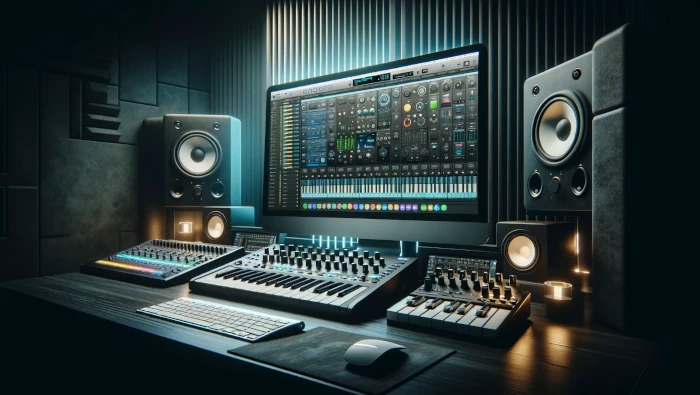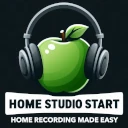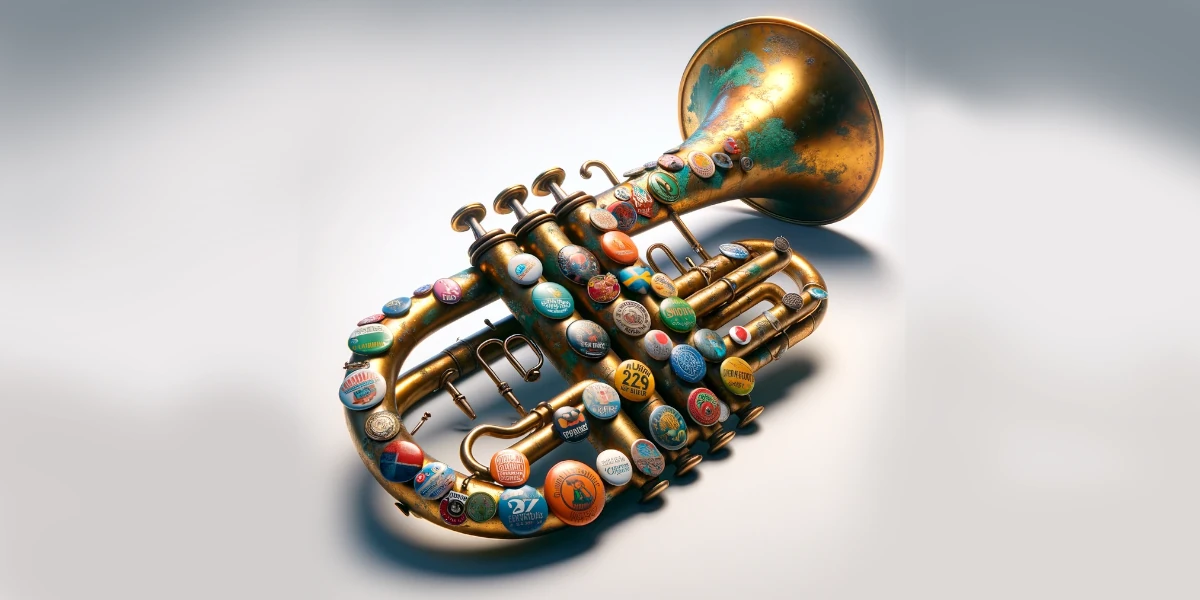Have you ever pondered if there might come a day when our cherished musical instruments gather dust or, worse, get tossed in the trash? It sounds almost blasphemous, doesn’t it? Yet, as we steer into the future of studio recordings, this question isn’t as far-fetched as it seems. The evolution of music production is upon us, morphing in ways that could lead many to retire their beloved guitars, at least during recording sessions.
In this era of rapid technological advancement, the realm of music isn’t untouched. The once clear line between physical instruments and their digital counterparts is blurring. Virtual instruments, powered by Virtual Studio Technology (VST), are stepping into the spotlight, promising a revolution in how we create, produce, and experience music. These digital marvels offer an accessible, cost-effective gateway into music production, challenging the traditional dominance of acoustic and electric instruments in the recording studio.
But what fuels this shift? Is it merely the allure of convenience and affordability, or is there a deeper, more profound transformation at play within the music industry? Let’s embark on a journey to explore the evolution of music production, from the tactile strumming of guitar strings to the click-and-drag melodies crafted in home studios around the globe. As we unravel the layers, we’ll discover how virtual instruments are not just changing the game but are also democratizing music production, making it possible for anyone with a passion for music to create, innovate, and inspire.
The Nostalgic Connection to Traditional Instruments
For many of us, our musical journey begins with a tangible connection to an instrument. Remember the first time you held a guitar? Maybe it was a friend’s, or perhaps it was a cherished birthday gift. There’s something profoundly personal about the feel of the strings under your fingers, the weight of the instrument in your arms. It’s not just an object; it’s a gateway to expression, a companion in creation. This emotional bond we form with musical instruments in our youth lays the foundation for a lifelong love affair with music.
This nostalgia isn’t about mere sentimentality; it’s about the irreplaceable experience of making music with something you can touch, feel, and hear in real-time. Traditional instruments like guitars, pianos, and violins have not only shaped the soundtrack of our lives but have also been central to the human experience of music for centuries. They carry stories, evoke emotions, and inspire creativity. For those deeply involved in music, be it through creation, production, or recording, the physicality of these instruments is an integral part of the musical expression.
Yet, as cherished as these instruments are, there’s an undeniable shift happening in the world of music production. The rise of digital music creation and home studios is slowly changing the landscape. This evolution poses a question: Can the nostalgic connection we have with traditional instruments coexist with the burgeoning digital music revolution? As we delve deeper into this transition, it’s essential to remember that at the heart of music is emotion and expression, regardless of the medium. The challenge and opportunity lie in bridging the gap between the tactile past and the digital future, ensuring that the soul of music remains untouched by the mode of its creation.
The Shift to Digital: Home Studios on the Rise
As the digital tide sweeps across the landscape of music production, a significant transformation is underway. Gone are the days when aspiring musicians and producers had to vie for time in professional recording studios, with their prohibitive costs and inaccessible equipment. Today, the rise of home studios marks a pivotal shift in how music is created, produced, and shared. This evolution is not just about technology; it’s about accessibility, empowering artists to bring their visions to life from the comfort of their homes.
The heart of this transformation lies in the increasing availability of audio hardware and software that can mimic, and sometimes surpass, the quality of professional studio recordings. The allure of digital music production tools lies in their ability to offer high-quality sound production without the need for expensive physical instruments. This democratization of music production tools has opened up a world of possibilities for creators, enabling anyone with a computer and a passion for music to explore their creativity.
Harmonizing Tradition and Technology: The New Era of Home Studios and Digital Music Production
The proliferation of digital audio workstations (DAWs), virtual instruments, and plugins has made the home studio model not just viable but often preferable. For aspiring musicians, the barriers to entry are lower than ever. What once required a significant investment in physical instruments and recording equipment can now be achieved with software. This shift is not merely about the practical aspects of music production; it’s a cultural change. It represents a move towards a more inclusive, innovative music creation space where the emphasis is on creativity and expression rather than financial investment.
Yet, with this shift comes a sense of nostalgia for the physicality of traditional instruments. While virtual instruments offer unprecedented accessibility and versatility, they also challenge the traditional tactile relationship between a musician and their instrument. The rise of home studios and digital music production tools heralds a new era in music creation, where the focus is on the seamless integration of technology and creativity. This shift to digital is not just changing how music is produced; it’s redefining what it means to be a musician in the modern world.
Embracing Virtual Instruments: The Game-Changing Solution

In the quest for professional sound quality, virtual instruments emerge as a beacon of hope for aspiring musicians and producers. These digital wonders, powered by Virtual Studio Technology (VST), offer a viable and revolutionary alternative to the costly endeavor of acquiring high-quality physical instruments. Virtual instruments are not just about cost savings; they represent a paradigm shift in music production, making it accessible to anyone with a computer and a creative spark.
A New Era of Music Production
The allure of virtual instruments lies in their versatility and the quality of sound they can produce. Imagine having an entire orchestra at your fingertips, or the ability to switch from a vintage electric guitar to a grand piano with just a few clicks. This level of flexibility was unimaginable in the era of traditional music production. Moreover, VST instruments cater to a wide range of genres and styles, offering endless possibilities for creativity and experimentation.
Virtual instruments are also incredibly user-friendly, making them suitable for both novices and seasoned professionals. With intuitive interfaces and the ability to integrate seamlessly into digital audio workstations (DAWs), these tools empower musicians to produce complex, high-quality music without the need for expensive studio time or equipment. The democratization of music production tools has led to a surge in home studios, enabling artists to produce music that competes with major studios’ outputs.
The shift towards virtual instruments is more than a technological trend; it’s a cultural movement towards inclusivity and innovation in music creation. By breaking down financial and logistical barriers, virtual instruments open the door to a world where creativity, not capital, is the key to professional music production. As we embrace these digital tools, we pave the way for a future where the power to create and share music is accessible to all, regardless of their means.
The Future of Music Production: Unlimited Potential
As we stand on the brink of a new era in music production, it’s clear that the advent of virtual instruments and digital technologies has not just transformed the landscape; it has unlocked a realm of unlimited potential. The democratization of music production tools means that the next groundbreaking track could come from anywhere—be it a high-tech studio in Los Angeles or a cozy bedroom setup in a small town. This shift heralds a future where creativity and innovation are the driving forces, unrestricted by the traditional barriers of access and cost.
Breaking Boundaries with Digital Innovation
The key to this limitless future is the continuous advancement in digital music production technologies. Virtual instruments, with their ever-improving realism and diversity, are just the tip of the iceberg. The integration of artificial intelligence, machine learning algorithms, and immersive audio technologies promises to further enhance the creative process, making it more intuitive and expressive than ever before.
This technological evolution will not only expand the horizons of what’s musically possible but also redefine the role of the musician. Artists will increasingly become architects of sound, blending traditional musical knowledge with cutting-edge technology to craft experiences that transcend conventional genres and mediums. The boundary between creator and technology will blur, with each amplifying the other’s potential to innovate and inspire.
Moreover, the future of music production lies in its ability to connect and collaborate. The digital age has made it easier for musicians from different corners of the globe to work together, sharing ideas and influences that enrich their music. This interconnectedness fosters a global musical dialogue, where diverse cultures and sounds merge to create something truly unique and universal.
In embracing the future, we acknowledge that the essence of music—its power to evoke emotion, tell stories, and bring people together—remains unchanged. What changes is how we harness that essence, using the tools and technologies at our disposal to ensure that music continues to evolve, resonate, and inspire, regardless of where it’s created or how it’s produced. The future of music production is not just about breaking new ground; it’s about making the ground fertile for all who wish to plant their creative seeds.
Conclusion: The Dawn of a New Era in Music
As we reflect on the transformative journey from the tactile strumming of strings to the click-and-drag symphonies of virtual instruments, it’s evident that we’re not just witnessing a change in the tools of music production. We’re standing at the dawn of a new era in music—a time when the barriers to entry are crumbling, and the power to create is being placed firmly in the hands of the many, not just the privileged few. This shift towards digital music production and virtual instruments marks a significant democratization of music creation, promising an inclusive and innovative future.
The evolution from traditional to virtual instruments is not a replacement but an expansion of the musical palette. It’s about augmenting the rich heritage of music with the endless possibilities of digital technology. This era is characterized by a spirit of exploration and the breaking down of genre boundaries, inviting artists and producers to experiment and innovate without limits.
Rewriting the Rhythms: Embracing a Future of Inclusive Music Creation
Moreover, this transition speaks to a broader cultural shift in how we perceive music production. It’s no longer about having access to the most expensive equipment or the most exclusive studios. Instead, it’s about creativity, vision, and the ability to connect with listeners on a profound level. The story of music is being rewritten, with technology as the pen that allows for a more diverse range of voices to be heard.
As we look to the future, it’s clear that the essence of music—its ability to express the inexpressible, to move us, and to bring us together—remains unchanged. What changes is how we create it, how we share it, and who gets to participate in its creation. The dawn of this new era in music is not just exciting for musicians and producers; it’s a beacon of hope for anyone who believes in the power of music to transform, to inspire, and to unite.
In embracing the limitless potential of virtual instruments and digital production, we’re not just making music accessible; we’re nurturing a global community of creators. This is a call to all aspiring musicians, producers, and dreamers: the future of music is wide open, and there’s a place in it for you. Let’s embrace this new era together, creating music that reflects the depth, diversity, and dynamism of our shared human experience.
Discover the World of Virtual Instruments
As we stand at the threshold of this exciting new era in music, the path forward is brimming with opportunities for innovation, creativity, and connection. Virtual instruments and digital production tools have opened up a universe of possibilities, waiting to be explored by those bold enough to embrace them. Whether you’re a seasoned musician or an aspiring producer, the world of virtual instruments is a treasure trove of inspiration, offering the tools to bring your musical visions to life.
Step into the Future of Music
Now is the perfect time to dive into the vibrant world of virtual instruments. If you’ve ever dreamed of crafting your own music, of weaving melodies and harmonies into something uniquely yours, the door is wide open. Virtual instruments offer a gateway to explore an expansive range of sounds—from the classic to the avant-garde, all without the need for physical space or a large investment.
Empower Your Creativity
Exploring virtual instruments isn’t just about access to a variety of sounds; it’s about empowering your creativity. With intuitive interfaces and the ability to customize every aspect of the sound, virtual instruments invite you to experiment, to play, and to discover new musical landscapes. If you know how to play the keyboard, you’re already equipped to venture into the realm of digital music creation, where the only limit is your imagination.
Join the Global Music Community
By embracing virtual instruments, you’re not just enhancing your own music production capabilities; you’re joining a global community of creators. This community thrives on collaboration, sharing, and mutual support, offering a wealth of resources for learning and growth. From online tutorials to forums and social media groups, there’s a vast network of fellow music enthusiasts ready to welcome you.
Take the First Step
Ready to embark on your musical journey? Start by exploring virtual instruments and digital audio workstations (DAWs). Many offer free trials or lite versions, allowing you to experiment and find the tools that resonate with you. Seek out tutorials, join online communities, and most importantly, allow yourself the freedom to create, to explore, and to express.
The future of music production is rich with potential, and it’s waiting for you. Don’t let this moment pass you by. Discover the world of virtual instruments today, and let your musical journey begin.
Look this video from YouTube about VST Instruments…

